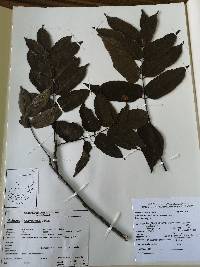
Neotropical Flora
|
Family: Anacardiaceae
[Astronium graveolens var. planchonianum (Engl.) Engl., moreAstronium mirandae F. A. Barkley] |
Dioecious tree, to 35 m tall and 80 (100) cm dbh; outer bark lenticellate, peeling off in small, +/- round patches leaving irregular shallow depressions; inner bark yellowish, granular, thick. Leaves imparipinnate, alternate; rachis and petiole 20-35 cm long; leaflets (2) 9-15, mostly opposite; petiolules to 6 mm long; blades lanceolate-oblong to elliptic, bluntly acuminate, acute to rounded and sometimes inequilateral at base, 4-14 cm long, 2-7 cm wide, glabrous or pubescent especially on veins below. Panicles terminal, to 25 cm long; pedicels 1-3 mm long (much longer in fruit), articulate; flowers unisexual, ca 2 mm long, 5-parted, yellowish-green; sepals ovate to elliptic, minute, enlarging to 1.5 cm and persisting as fruit matures; petals to 3 mm long, +/- elliptic; staminate flowers with 5 stamens to 3 mm long; pistillode lacking; pistillate flowers with the styles 3, ca 1 mm long, persistent or deciduous; stigmas small, disciform; ovary ovoid-oblong, with a single subapical ovule; staminodia reduced. Drupes narrowly oblong, 1-1.5 cm long, subterete. Croat 13492. A few individuals are known in the old forest; seedlings, however, are rather common. Plants lose their leaves for a short time just before flowering, and new leaves appear with the flowers in the late dry season. The fruits develop quickly and are dispersed in the late dry and early rainy seasons. In Mexico, the fruits mature from April to June (Pennington & Sarukhan, 1968). |
|
|
|
Powered by Symbiota.
















































